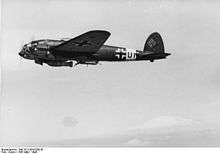SC1000 bomb
| SC 1000 | |
|---|---|
 SC 1000 in cross-section without tail | |
| Type | General purpose HE bomb |
| Place of origin | Germany |
| Service history | |
| Used by | Luftwaffe |
| Wars | World War II |
| Specifications | |
| Weight |
|
| Length |
|
| Diameter |
|
|
| |
| Filling |
Amatol (60%) / TNT (40%) Trialen 105 |
| Filling weight |
|


The SC 1000 (Sprengbombe Cylindrisch 1000) was a large air-dropped general-purpose thin cased high explosive demolition bomb used by Germany during World War II. Weighing more than 1,000 kg (2,200 lb), it was nicknamed the Hermann by the Germans in reference to the portly Luftwaffe commander, Hermann Göring.
Design
The bomb had a body of drawn steel to which a heavy pointed nose cone was welded. At the other end was a base plate, just forward of which the magnesium alloy tail was tack welded onto the body, and also bolted to the tail attachment brace. Around the nose of the bomb was a kopfring - a metal ring, triangular in cross section, designed to prevent ground penetration or to stop forward momentum when hitting water. The bomb was attached to the aircraft horizontally by a H-type suspension lug.[1]
The bomb was fitted with a single transverse fuze pocket. The bomb was usually filled with a mixture of 40% amatol and 60% TNT, but when used as an anti-shipping bomb it was filled with Trialen 105, a mixture of 15% RDX, 70% TNT and 15% aluminium powder. A central exploder tube of high grade TNT was put down the centre of the explosive to ensure high order detonation.[1]
The bombs were painted sky-blue with a yellow stripe in the tail cone, unless filled with Trialen in which case it was replaced by the silhouette of a sinking ship in yellow, and the warning nur gegen handelschiffe ("only against merchant ships") was stencilled on the bomb casing.[1]
Variants
There were three variants of the bomb, designated Type C, L and L2, all of the same design, but which varied slightly in size and weight.[1]
Fuzes
The bomb was fitted with a variety of fuzes including:
- Type 25B electric impact fuze. This could be set to instantaneous detonation, short delay (less than 1 second), or for a 17-second delay.[2]
- Type Z17 mechanical clockwork time fuze. A time-delayed fuze able to be set from between 3 and 135 minutes.[3]
- Type 28B, 38 and 38A electric impact fuze, designed for use against shipping.[4]
Post war incidents
2008 London bomb
In early June 2008 an SC 1000 bomb was dredged from the River Lea near Three Mills Island in London. The bomb was defused and the explosive liquefied and pumped out using steam by bomb disposal officers from the Royal Engineers before the bomb was destroyed in a controlled explosion after five days.[5][6]
2013 Szczecin bomb
In June 2013 an SC 1000 bomb was recovered from the Odra in central Szczecin, Poland. The area was evacuated while the bomb was lifted from the river by military engineers, and then taken in convoy to an Army training base near Drawsko Pomorskie to be destroyed in a controlled explosion.[7][8]
2013 Belgrade bomb
In early December an SC1000 bomb was recovered in the inner city of Belgrade. The area was evacuated while the bomb was lifted by the engineers of the Department for the Unexploded Ordnance of the Sector for Emergency Management of the Ministry of Interior, and then taken in a convoy to an Army training base at Nikinci to be destroyed in a controlled explosion.[9]
See also
References
- Notes
- 1 2 3 4 TM 9-1985-2 (1953), pp.9-10
- ↑ TM 9-1985-2 (1953), p.141
- ↑ TM 9-1985-2 (1953), p.155
- ↑ TM 9-1985-2 (1953), pp.163-166
- ↑ "WW2 bomb detonated". bbc.co.uk. 5 June 2008. Retrieved 15 June 2013.
- ↑ Singh, Rob (5 June 2008). "The ticking Blitz bomb that threatens east London". London Evening Standard. Retrieved 15 June 2013.
- ↑ Adamowska, Monika; Łukaszuk, Anna (30 June 2013). "To była niemiecka bomba Herman. Została już zdetonowana na poligonie". szczecin.gazeta.pl (in Polish). Retrieved 1 July 2013.
- ↑ "Wojsko wyciąga bombę z Odry. Wielka ewakuacja Starego Miasta". szczecin.gazeta.pl (in Polish). 30 June 2013. Retrieved 1 July 2013.
- ↑ "Izvadena bomba, danas deaktiviranje" [Bomb is removed today and deactivated]. b92.net (in Serbian). 8 December 2013. Retrieved 8 December 2013.
- Bibliography
- "Army Technical Manual TM 9-1985-2/Air Force Technical Order TO 39B-1A-9 German Explosive Ordnance (Bombs, Fuzes, Rockets, Land Mines, Grenades & Igniters)" (PDF). HyperWar. March 1953. Retrieved 15 June 2013.